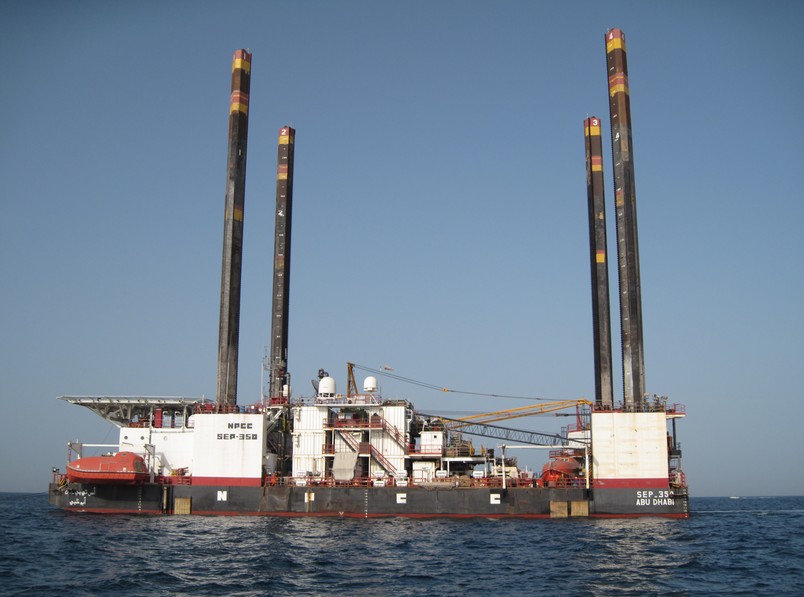PLATEFORME PETROLIERE NPCC - SEP350 - ABU DHABI
National Petroleum Construction Company (NPCC) est en charge de la construction des infrastructures pétrolières pour les Emirats Arabes Unis et le Moyen-Orient.
Une plate-forme auto-élévatrice ou jackup plate-forme est un type de plate-forme mobile qui se compose d'une coque flottante munie d'un certain nombre de jambes mobiles, capables d'élever sa coque au-dessus de la surface de la mer. La coque flottante permet le transport de l'accommodation et toutes les machines et outils à un emplacement souhaité. Une fois sur place la coque est élevée à la hauteur requise au-dessus de la surface de l'eau supporté par le fond marin. Les jambes de ces unités peuvent être conçues pour pénétrer dans le lit de la mer mais peuvent aussi être équipées avec des sections élargies ou des semelles, ou encore même être attaché à un tapis de fond. Généralement les plates-formes auto-élévatrices sont pas autopropulsées et requièrent des remorqueurs ou des navires de transport lourd pour le transport.
Barges
Les plates-formes auto-élévatrices se réfèrent également à des barges spécialisées qui sont semblables à une plate-forme pétrolière et/ou de gaz, mais qui sont utilisés comme base pour l'entretien d'autres structures telles que les éolienne offshore, l'équipement de forage ou les long ponts.
---------------------------------------------
National Petroleum Construction Company (NPCC) began, more than 40 years ago, from the vision of the Late President of the United Arab Emirates, His Highness Sheikh Zayed Al Nahyan and was established to serve the growing Oil and Gas sector of the United Arab Emirates and the Region.
A jackup rig or a self-elevating unit is a type of mobile platform that consists of a buoyant hull fitted with a number of movable legs, capable of raising its hull over the surface of the sea. The buoyant hull enables transportation of the unit and all attached machinery to a desired location. Once on location the hull is raised to the required elevation above the sea surface supported by the sea bed. The legs of such units may be designed to penetrate the sea bed, may be fitted with enlarged sections or footings, or may be attached to a bottom mat. Generally jackup rigs are not self-propelled and rely on tugs or heavy lift ships for transportation.
Barges
Jackup rigs also refer to specialized barges that are similar to an oil and gas platform but are used as a base for servicing other structures such as offshore wind turbines, long bridges, and drilling platforms.
A long flat-bottomed boat for carrying freight on canals and rivers, either under its own power or towed by another.
A barge is a flat-bottomed boat, built mainly for river and canal transport of heavy goods. Some barges are not self-propelled and must be towed or pushed by towboats. Canal barges, towed by draft animals on an adjacent towpath, contended with the railway in the early Industrial Revolution, but were outcompeted in the carriage of high-value items due to the higher speed, falling costs and route flexibility of railways.
Jackup rigs also refer to specialized barges that are similar to an oil and gas platform but are used as a base for servicing other structures such as offshore wind turbines, long bridges, and drilling platforms.
A long flat-bottomed boat for carrying freight on canals and rivers, either under its own power or towed by another.
A barge is a flat-bottomed boat, built mainly for river and canal transport of heavy goods. Some barges are not self-propelled and must be towed or pushed by towboats. Canal barges, towed by draft animals on an adjacent towpath, contended with the railway in the early Industrial Revolution, but were outcompeted in the carriage of high-value items due to the higher speed, falling costs and route flexibility of railways.
